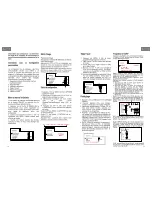
9
CIRCUIT DESCRIPTION
26
9.7.4
Line timebase
The control voltage of pin 37 of the Bimos ic (=ic7100) is
derived via opto coupler pos 7420 to transistor T7421; then
send via C2428 and C2421 to pins 5 and6 of connector 0082;
this is the control of the base of T7906 (=BU1508AX). At the
flyback diode between collector and mass there are two parts
present to allow the East/west modulation. One part of this
modulator consists of D6906, T7908, C2910 and C2911. The
second part another diode is not visible in the circuit diagram
but it is present in the MosFet 7908.
On pins 1 and 2 of the module the primary side of the LOT is
connected. The LOT supplies the following voltages:
•
3-5 : 26 Volts after smoothing
•
10-8: 14 Volts
•
9 : 160 volts for video amplifiers.
9.8
BIMOS IC: PAL I Version
9.8.1
Introduction
The TDA 8361 is a single chip video and audio processor and
it incorporates a built in IF-detector, Luminance and
Chrominance separator, PAL/NTSC Chroma Decoder, RGB
processing, Horizontal and Vertical Oscillators, Sync
Separators and the FM Sound demodulation circuit.
9.8.2
Bimos Start Up
The Bimos device (Line Oscillator) starts up via pin 36,
however it will only start up when the voltage on this pin has
reached 5.6 Volts. At 5.6 Volts the output frequency will be
about 25kHz. The supply voltage at this pin (Pin 36) is
produced by the Switched Mode Power Supply and not by the
Line Out Put Stage. Once the supply voltage on Pin 10 has
(Line Output Stage) reached the 8-volt threshold the output
frequency will switch to 15.625 kHz. The voltage on this pin is
prevented from exeading 8 volts by zener diode 6106 (Page
10)
9.8.3
Horizontal Sync Separator
This functional block separates the horizontal sync pulses from
the CVBS and then locks the pulses to the free running
horizontal sawtooh generator. However both the vertical and
horizontal oscillators are also internally locked to the 4.43 MHz
Chroma reference Crystal item 1100.
•
The Horizontal Oscillator Saw Tooth Generator The
sawtooth is converted to a square waveform with a variable
duty cycle. This square waveform is then fed to the Line O/
P stage via a Galvanic Isolator. The correct line time
constant is automatically determined, internally by the
BIMOS IC.
•
Pin 38 This is pin has two purposes, these are.
1.
The Sandcastle Pulse O/P
2.
Horizontal Flyback Pulse Input
1.
The Sandcastle Pulse has an output current of a few
micro amps; the amplitudes of the sandcastle pulse
components are: Burst 5V3; Line Blanking 3V and
Frame Blanking 2V.
2.
The HOR FLYBACK input has a current of 100-300 uA.
The Horizontal flyback pulse input, allows the phase of
the flyback pulse to be compared internally with the
phase of the horizontal oscillator; if the phase is not
correct, the horizontal oscillators duty cycle will be
adjusted accordingly.
9.9
Vertical Synchronisation and Frame Amplifier
9.9.1
The Vertical Sync Separator
This functional block separates the Frame Synchronisation
pulses from the CVBS signal, once these pulses have been
separated the pulses are then used to synchronise the Frame
Oscillator.
9.9.2
Amplitude
The voltage on pin 42 of the BIMOS device determines the
amplitude of the frame sawtooth.
9.9.3
Frame Pre Amplifier
This internal amplifier increases the amplitude of the Frame
sawtooth, from here the frame sawtooth is available at pin 43.
9.9.4
BCI Input Pin
This Input is fed into the BIMOS device form the Tube Base
Board, It is used to provide frame correction for changes in the
EHT voltage. For example if the EHT decreases (more white)
the picture will get larger. This results in the BCI decreasing
and the picture size being automatically corrected by the
BIMOS.
9.9.5
The IF Demodulator
The IF bandpass characteristic is determined by SAW filter
1001. The IF signal is then fed from here into BIMOS pins 45
and 46. Pin 1 of the IC is used for the selection of positive or
negative video modulation. It is high for positive modulation
and low for negative.
9.9.6
AGC
Pin 47 is used for AGC (AGC is used to adjust the gain of the
Tuner so that over modulation is avoided).
9.9.7
AGC Threshold Adjustment
Variable resistor R3130 which is connected to pin 49 adjusts
the AGC Threshold
9.9.8
Automatic Frequency Control/ Pin 44
The AFC control signal is available at pin 44 of the BIMOS
device. It is obtained from the internal IF reference signal.
C2100 is used to smooth the AFC voltage.
9.9.9
IDENT Signal/ Pin 4
The IDENT signal on pin 4 is "High" when horizontal sync is
detected in the video signal and low when no sync is detected.
The IDENT line is connected to the main Microprocessor.
(Pin15)
9.9.10 What does the IDENT line do ?
It is used for tuning control (for switching from fast to the slow
tuning mode) Pin 4 (BIMOS) is also used by the
microprocessor (Pin15) for "No Signal Standby" after 15
minutes. Used to provide a stable OSD - Time constant
switched by the BIMOS.
Содержание 286NS-05
Страница 14: ...10 Direction for use 28 Comet 10 Direction for use ...
Страница 15: ...10 Direction for use 29 Comet ...
Страница 16: ...10 Direction for use 30 Comet ...
Страница 17: ...10 Direction for use 31 Comet ...
Страница 18: ...10 Direction for use 32 Comet ...
Страница 19: ...10 Direction for use 33 Comet ...
Страница 20: ...10 Direction for use 34 Comet ...
Страница 25: ...6 Overview oscillograms 10 Comet ...
Страница 34: ...7 Electrical diagrams and print lay outs 19 Comet CL 86532029_008 eps 240698 ...













































